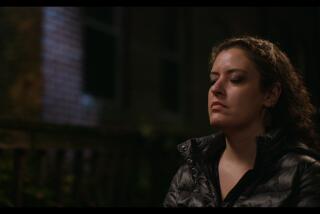MOVIE REVIEW : Well-Meaning but Tired ‘Awakenings’
In his book “Awakenings,” the neurologist Oliver Sacks describes how, as a young doctor in 1969, three years after entering Mt. Carmel Hospital in the Bronx, he administered the drug L-DOPA to post-encephalitic patients who had survived the worldwide sleeping-sickness epidemic of the ‘20s.
In almost every case he observed in them an astonishing renewal. These people--most of them “frozen,” trancelike, vegetating in hospitals--were considered beyond recovery. L-DOPA “awakened” them to life. Suddenly and astonishingly, they were able to converse, ambulate, write, laugh. But the reawakening short-circuited. The drug proved no magic elixir, and most of the patients slipped back into their own sentient but private oblivion.
The movie adaptation of Sacks’ book centers on one of its many case histories. It’s about the relationship between Dr. Malcolm Sayer (Robin Williams)--based in part on Sacks--and the virtually voiceless and immobile Leonard Lowe (Robert De Niro), who contracted encephalitis 30 years earlier, and whose mother (Ruth Nelson) still tends to him.
The raw material of Sacks’ account is so powerful that it almost sustains the soft-edged film that has been adapted from it. Sometimes a less-than-stellar movie can reach into areas of dread and poignancy that are as emotionally affecting as the stellar stuff; the mistake is in assuming that because we get the sniffles the film must be great.
As well-meaning and “sensitive” as “Awakenings” is, it never rises much above the level of a grade-A tear-jerker. It achieves most of its effects by tenderizing raw material into something marshmallowy.
This is not to say that director Penny Marshall pulls out all the stops. As she demonstrated with “Big,” to which “Awakenings” (throughout San Diego County) bears a thematic resemblance, Marshall has a gift for reticence. She has the taste to cut short most of the big moments in “Awakenings” before they get all slobbery and fake. But her sense of reserve also keeps the film from truly engaging us. It pulls back from the true terror of the unawakened lives we are shown, and so their reawakening lacks force.
Besides Leonard, the post-encephalitic patients we see are too contourless and sanitized. Nobody slobbers in this film, no one has any embarrassing sexual or excretory compulsions. Dementia is downplayed. In one of the film’s centerpiece scenes, the awakened patients go on a field trip to a dance hall in the Big Apple, where they carry on like they were in a ‘20s speak-easy.
It’s not that something like this didn’t, or couldn’t, happen. It’s that the film (rated PG-13 for strong language) has reduced the patients’ lives to easily comprehensible casebook anecdotes. The patients have the companionable quality of treasured pets, and there’s a measure of unconscious condescension in the way they are made to gambol and twirl and make nice.
In the process, Sayer’s full humanity is also reduced. Steve Zillian’s script goes for the most obvious connection. It explains the doctor’s passion for helping his patients by positing a spiritual link between them: Sayer, a private man, is really “one of them.” He is first introduced to us as a “pure” researcher with no people skills. He lives in a crummy bachelor apartment and won’t allow himself to acknowledge the attentions of his nurse (Julie Kavner).
But, of course, Sayer is actually a people person par excellence . In his attempt to put all his encephalitic patients on L-DOPA, he breaks through the stonewalling of the hospital’s medical Establishment--a cadre of lily-livered meanies headed by John Heard’s Dr. Kaufman--and finally gets his way.
The predicament of his patients--played by, among others, Anne Meara, Alice Drummond, the late Dexter Gordon and Judith Malina--effects a kind of awakening on Sayer himself. In the film’s own allegorical terms, Sayer’s kinship with Leonard teaches him to love. Leonard’s re-entry into oblivion forces his doctor’s rebirth.
It’s a tribute to the acting of Williams and De Niro that this kinship doesn’t seem achingly schematic. But the conception of their roles is a bit too squishy and Teddy-bearish for my taste. Sayer is supposed to gain from his experience with Leonard by recognizing what is precious in life. But Sayer is never made to recognize his kinship with Leonard’s dark side--his agonies. Williams allows few shadows to creep into Sayer’s radiance.
De Niro has the more difficult role; at least it’s the more technically difficult. And because it’s De Niro, we’re primed for a tour de force--a post-encephalitic “Raging Bull” star turn. What we get instead is something sweet and full of feeling and a little wan.
In the beginning of the film, Leonard, in his trancelike state, first convinces Sayer that he has an active inner life by spelling out a reference to a poem by Rilke. But, once awakened, Leonard seems to have no need for Rilke--or for much of anything else in the arts.
Did the filmmakers think we might lose sympathy with Leonard if he demonstrated a life-sustaining love for literature, for music, for painting? (The “Leonard L” of Sacks’ book, in his lucid states, was a fiercely eloquent intellectual.) Instead, he demonstrates his tenderness in a series of quasi-romantic interludes with an endlessly “understanding” young woman (Penelope Ann Miller) who visits her stroke-incapacitated father in the hospital.
If “Awakenings” had been made 20 years ago, it might have opted for a “Cuckoo’s Nest”-style scenario in which the encephalitic patients were shown to be more fully alive, more sane, than their overseers. There’s a smidgen of this attitude in the film, but, mostly, it’s “Rain Man” redux--”Brain Man.” Leonard’s life is employed not as a paragon but as a beacon. Sayer learns that “the simplest things matter.” The trouble with “Awakenings” is that the simplest things are too simple.
‘Awakenings’
Robin Williams: Dr. Malcolm Sayer
Robert De Niro: Leonard Lowe
Julie Kavner: Eleanor Costello
Ruth Nelson: Mrs. Lowe
A Columbia Pictures release. Director Penny Marshall. Producers Walter F. Parkes and Lawrence Lasker. Executive producers Penny Marshall, Arne Schmidt, Elliott Abbott. Screenplay by Steve Zillian. Cinematographer Miroslav Ondricek. Editor Jerry Greenberg. Costumes Cynthia Flynt. Music Randy Newman. Production design Anton Furst. Art director Bill Groom. Set decorator George De Titta Jr. Sound Les Lazarowitz. Running time: 2 hours, 1 minute.
MPAA-rated PG-13 (occasional strong language).
More to Read
Only good movies
Get the Indie Focus newsletter, Mark Olsen's weekly guide to the world of cinema.
You may occasionally receive promotional content from the Los Angeles Times.










